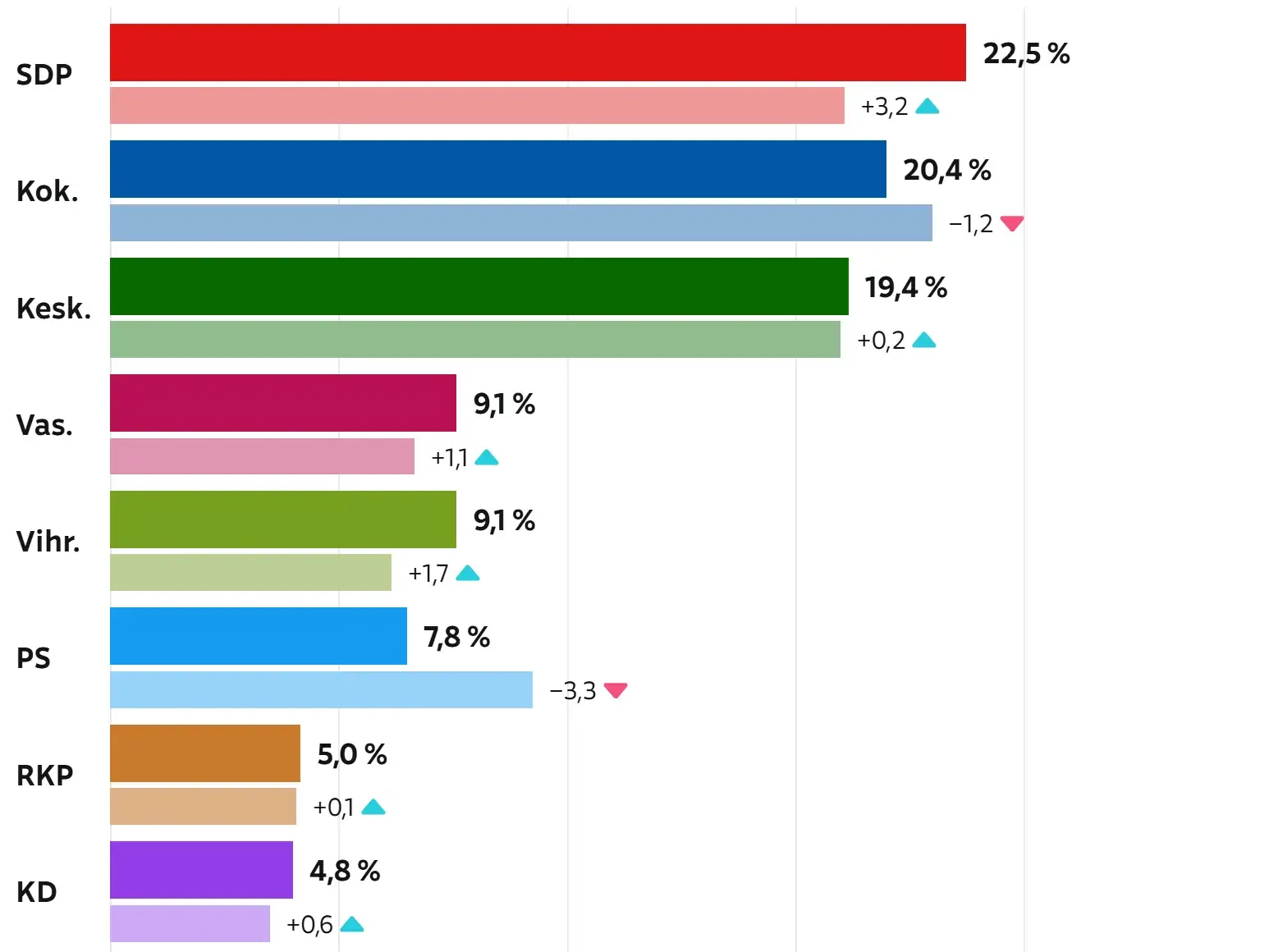
Antti Lindtman, chairman of the election-winning SDP, commented on the result on Monday. Source: Yle
The Social Democratic Party, which campaigned for a fairer society, won a landslide victory over the Coalition Party in both the municipal and regional elections, held last weekend.
At the same time, the Coalition Party’s four-election winning streak ended at the peak of the municipal elections.
The turnout in the regional elections was 51.7 (previously 47.5) and the turnout in the municipal elections was 54.2 (previously 55.1).
Following the parliamentary elections in April 2023, the most right-wing government since World War II was formed in Finland, represented by the old Coalition Party, the far-right Finns Party, and two small parties representing Finnish Swedes and Lutherans, for which 49.41 per cent of voters voted. The ruling parties are currently represented in the unicameral parliament by 108 out of 200 deputies.
Regional and municipal elections held last weekend gave the ruling parties a sobering result: just over a third of voters voted for them, a modest 38 per cent. In fact, this is a real political catastrophe for the coalition: from a powerful political force, the second most popular party, which received 20.6 per cent of the vote in the 2023 parliamentary elections, the descendant of the Finnish “Blue-and-Blacks” fascists, the Finns Party has overnight turned into a political dwarf with its 7,8 per cent, and the main right-wing conservative National Party lost to its main political rivals, the Social Democrats.
Thus, as of Monday morning, April 14, the actual chapter of Finnish political history has closed: the current government no longer represents the majority of citizens, but has become a lame duck that must explain to voters by what right it intends to function until April 17, 2027, when the next parliamentary elections will take place.
The reasons for the Finnish political revolution are revealed below.
The situation in the municipal and regional elections was merciless for the governing parties.

SDP (Social Democratic Party), Kok.(National Coalition Party), Kesk. (Centre Party), Vas. (Left Alliance), Vihr.(Green League), PS (Finns Party, former True Finns Party), RKP (Swedish People’s Party), KD (Christian Democrats). The results of previous elections are shown in pale color. Source: Yle
Throughout the spring, the government has had to justify why the care guarantee was extended to three months from the previous two weeks and why social security is being cut.
On the first day of the advance vote, Minister of Social Affairs and Health Kaisa Juuso (PS) presented a savings list in Parliament that will reduce spending on both child welfare and elderly care.
The decision to cut night shifts in several hospitals is also a burden.
The Left’s Victory Speaks Of Protest
Over the past two years, the National Coalition Party, the Finns Party, the Christian Democrats and the Christian Democrats have implemented cuts and tax increases that have drained the public finances by nine billion euros. About a third of the cuts in social spending were spent on military and humanitarian aid to Ukraine. Since February 2022, Finland has allocated around 3,2 billion euros in aid to Ukraine.
Welfare areas have also had to save on services and personnel, which has been reflected in the constant headlines about the crisis in elderly care, child welfare and health services.
The local elections can be interpreted as a protest by the Finns, as the opposition parties gathered support at the expense of the government.
The chairman of the Social Democratic Party Antti Lindtman immediately interpreted that the election result shows the Finns’ desire for change.
The National Coalition Party’s Petteri Orpo interpreted the result differently. According to him, Finns still appreciate the National Coalition Party’s responsibility in difficult times. According to Orpo, the election result is a tough one for the party, even though it did not come in first place.
The Coalition Party’s goal was to win this election as well, and losing first place is also a painful defeat for Chairman Orpo.
The Coalition Party campaigned until the last moment with responsible economic policy and the fact that one cannot live on debt and taxes indefinitely. Under the leadership of Minister of Finance Riikka Purra, known worldwide for her racist comments, the Finns Party’s message was the same, and there were no promises of additional money—quite the opposite.
The Collapse Of The Finns Party Destabilises The Government
The poor success of the Finns Party is crushing. The party was receiving less than eight per cent support in the municipal and regional elections and had fallen behind the Left Alliance and the Greens.
Chairman Riikka Purra recently explained the result by saying that the party’s supporters are more interested in the parliamentary elections.

The Finns Party lost almost half of its voters in the election. Chairwoman Riikka Purra monitored the vote count on election day. Source: Yle, Emmi Korhonen
The party has also failed to hold on to its councillors. According to a Yle report, over a hundred Finns Party municipal councillors defected from the party during the last term.
The Finns Party is already burdened by the failed European elections, in which the party’s number of MEPs fell from two to one.
A weak election result could portend difficulties within the government, but the party is unlikely to seek the fall of the government immediately after such an election result.
After the elections, the governing parties are expected to prepare for new difficult decisions if the debt situation is not resolved.
But will Riikka Purra continue to search for savings as hawkishly as before? The collapse in support is a warning sign for the party in any case.
The Centre Party Is Not Disappearing
The joy among the Centre Party’s election observers was boundless on Sunday.
In its home turf, the party redeemed the trust of its supporters in the regional and municipal elections. The Centre Party was on course to take third place in the municipal elections and second place in the regional elections.
Measured by the number of councillors, the Centre Party seemed to retain its position as the largest municipal party in Finland, meaning it was gaining the most councillors.
The Coalition Party Lost The Mayoralty
Losing power in the large cities in the south is one of the most painful consequences of the elections for the Coalition Party.
In Turku, the power structure is being shaken as the Coalition Party is losing its almost historic number one position to the SDP. Current mayor Minna Arve would thus be making way for the SDP’s Piia Elo. Elo has served as deputy mayor of education and training in Turku last term.
In Tampere, the SDP’s Ilmari Nurminen is strongly tipped to be the mayor. Kalervo Kummola would thus come in second.
In Helsinki, the support of the SDP and the Coalition Party was neck and neck late in the evening measured by the number of councillor seats, but the Coalition Party was winning in support. This would put Daniel Sazonov in a stronger position to be mayor than Eveliina Heinäluoma of the Social Democratic Party.
In the coming weeks, cities will see who the councils will support, but traditionally the candidate of the party with the most votes has become mayor.
New Councillors Start Delivering On Their Promises
Were the local elections a barometer of national politics or did people vote for local themes?
The relative of an elderly person waiting for a place in an institution, the father waiting for a decision on the care of a disabled child, or the job seeker may have voted in this election for someone they hope will advance their cause.
Many people who are trusted won this election.
Here Is One Reason Why The Support For The Finns Party Collapsed: Arrogant Communication
Finns can tolerate cuts if they are justified, says Juhana Aunesluoma, professor of political history at the University of Helsinki.
Aunesluoma considers it exceptional that the Finns Party has started making jokes about cuts.
The image that has stuck on the retinas of the eyes is the image of Finance Minister Riikka Purra (PS) with a smiley face and scissors in hand.
When difficult decisions are made, they need to be communicated. It may be that the style of communication has been such that it has also exceeded the threshold of irritation among Finns Party supporters.
After the elections, Finance Minister and Chairwoman Riikka Purra announced that she would continue in the same way.
Minister of Social Affairs and Health Kaisa Juuso (PS) also gave an arrogant impression in the parliamentary interpellation debate on social and health care cuts.
In the interpellation, the opposition accused the government of concealing the 170 million euro surgery list before the elections.
In the debate on home care savings, Juuso shocked the public by saying that “some elderly people may be satisfied when home care does not come in with their own keys five times a day.”
Juuso’s justification for home care cuts was unsuccessful, assessed Markku Jokisipilä, professor of political history at the University of Turku.
“Juuso should have responded a little differently here and not tried to defend the deterioration of the service level with such an argument.”
“When drastic decisions have to be made, perhaps they should not be made with a mocking smile on their face.”

Minister of Social Affairs and Health Kaisa Juuso responded to the opposition’s interpellation on social care cuts. The opposition accused the government of concealing the 170 million euro cuts before the elections. Photo: Yle, Silja Viitala
Confrontation does not bite in the municipal elections
Experts interviewed by Yle emphasise that there is no single reason for the election defeat. According to Jokispilä, the election result shows that building a confrontation does not necessarily work in regional and municipal elections.
“That is where cooperation skills, negotiation skills, and the ability to find compromises are needed. Populist confrontation does not work in municipal politics and does not bring credibility.”
Professor Juhana Aunesluoma estimates that the Finns Party should correct its communications at the latest now.
“Of course, there may also be genuine disappointment with how extensive these cuts are. But the way in which they have been communicated does not make it easier.”
The minister who makes cuts may become the favorite
Based on the election result, the government’s cuts are seen above all in the support of the Finns Party.
Supporters of the Prime Minister’s National Coalition Party seem to accept the government’s policies better than voters of the Finns Party.
“Compared to the National Coalition Party, the Finns Party is a young party. Now we are really just testing the attitude of the supporters and party activists to a stricter economic policy,” says Aunesluoma.
Cutting can also make a politician popular. The National Coalition Party’s Finance Minister Iiro Viinanen (1991–1995) saved and cut 4.2 billion euros in current money during the recession year of 1994.
Despite this, the people loved Viinanen. Viinanen knew how to justify himself and the people endured.
“The economic pit and gloom were of a deeper order of magnitude. At that time, there was a national consensus that even tough measures had to be taken,” Jokisipilä recalls.
Another popular fiscal discipliner was President Sauli Niinistö, who succeeded Viina as Minister of Finance in 1996. That was the beginning of Niinistö’s popularity.
Source:
- SDP voitti, PS romahti—lue tästä vaalien eri käänteet / Yle (in Finnish)
- Tässä yksi syy, miksi perussuomalaisten kannatus romahti: ylimielinen viestintä / Yle (in Finnish)
- Analyysi: Vasemmisto voitti ja perussuomalaiset murskattiin—nämä asiat vaalitulos muuttaa Suomessa / Yle (in Finnish)

Independent Expert

